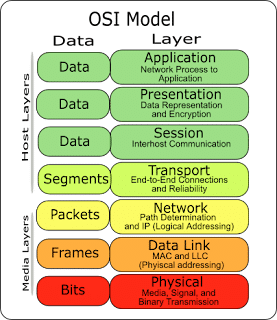It enables a user whether a human or software to access the network. It provides user interface and support for services such as e-mail, remote file access and transfer share database management, and other types of distributed information services.
Provides a set of interfaces for applications to use to gain access to networked services.
File transfer, access, and management : The application allows the user to access files in a remote host (to make changes or read data), to retrieve files from a remote computer for use in the local computer, and to manage or control files in a remote computer locally.
Mail services : The application provides the basis for e-mail forwarding and storage.
Directory services : This application provides distributed database source and access for global information about various objects and services.
The Presentation layer manages data-format information for networked communications. Also called the network’s translator, it converts outgoing messages into a generic format that can be transmitted across a network; then, it converts incoming messages from that generic format into one that makes sense to the receiving application. This layer is also responsible for protocol conversion, data encryption and decryption, and graphics commands. Information sent by the Presentation layer may sometimes be compressed to reduce the amount of data to be transferred.
The presentation layer is concern with the syntax and semantics of the information exchanged between two systems.
The presentation layer Converts data into a generic format for network transmission; for incoming messages, it converts data from this format into a format that the receiving application can understand.
The Session layer allows two networked resources to hold ongoing communications, called a session, across a network. In other words, applications on each end of the session are able to exchange data for the duration of the session.
The session layer is the network dialogue controller. It establishes maintenance and synchronized the interaction between the communication devices.
Session layer Enables two parties to hold ongoing communications—called sessions—across a network.
Specific responsibilities of the session layer include following :
The Transport layer manages the flow control of data between parties across a network. It does layer this by segmenting long streams of data into chunks that adhere to the maximum packet size for the networking medium in use. The layer also provides error checks to guarantee error-free data delivery, and resequences chunks back into the original data when it is received. In addition, the large Transport layer provides acknowledgement of successful transmissions and is responsible for requesting retransmission if some packets do not arrive error-free.
The transport layer is final responsible for process-to-process delivery of the entire message. The process is an application program running on the host.
Transport layer Manages the transmission of data across a network.
Other responsibilities of the transport layer include the following :
The Network layer addresses messages for delivery, and translates logical network addresses and names into their physical equivalents. This layer also decides how to route transmissions between cog computers. To decide how to get data from one point to the next, the Network layer considers other al factors, such as quality of service information, alternative routes, and delivery priorities. This layer also handles packet switching, data routing, and network congestion control.
The network layer is responsible for the delivery of individual packets from the source host to the the destination host.
Network layer Handles addressing messages for delivery, as well as translates logical network addresses and names into their physical counterparts.
If two systems are connected to the same link, there is usually no need for a network layer. or However, if the two systems are attached to different networks (links) with connecting devices the between the networks (links), there is often a need for the network layer to accomplish source-to destination delivery.
Other responsibilities of the network layer include the following :
Logical addressing : The network layer adds a header to the packet coming from the upper layer that, among other things, includes the logical address of the sender and receiver which help to distinguish the source and destination systems.
Layer 2 : The Data Link Layer
The Data Link layer handles special data frames between the Network and Physical layers. At the receiving end, this layer packages raw data from the Physical layer into data frames for delivery to the Network layer. A data frame is the basic unit for network traffic as data is sent across the network medium; the data frame is a highly structured format in which data from upper layers is placed for sending, and from which data from upper layers is taken on receipt.
The data link layer is responsible for moving frames from one hop (node) to the next.
Data Link layer Sends special data frames from the Network layer to the Physical layer.
Other responsibilities of the data link layer include the following.
Framing : The data link layer divides the stream of bits received from the network layer into manageable data units called frames.
Physical addressing : If frames are to be distributed to different systems on the network, the data link layer adds a header to the frame to define the sender and/or receiver or the frame. If the frame is intended for a system outside the sender’s network, the receiver address is the address of the device that connects the network to next one.
Flow control : If the rate at which data are absorbed by the receiver is less then the rate at which data are produced in the sender, the data link layer imposes a flow control mechanism to avoid overwhelming the receiver.
Error control : The data link layer adds reliability to the physical layer by adding mechanism to detect and retransmit damaged or lost frames. It also uses a mechanism to recognize duplicate frames. Error control is normally achieved through a trailer added to the end of frame.
Access control : When two or more devices are connected to the same link, data link layer protocols are necessary to determine which device has control over the link at any given time.
The Physical layer converts bits into signals for outgoing messages, and signals into bits for incoming ones. This layer arranges the transmission of a data frame’s bits when they are dispatched across the network. The Physical layer manages the interface between a computer and the network medium, and instructs the driver software and the network interface as to what needs to be sent across the medium. That concludes the layer-by-layer discussion of the OSI Reference Model. Now, let’s take a look at how the IEEE 802 specifications further standardized.
Physical layer Converts bits into signals for outgoing messages, signals into bits for incoming messages.


 IBPS SO Salary 2024, In Hand Salary, Job...
IBPS SO Salary 2024, In Hand Salary, Job...
 Documents Required for IBPS PO Interview
Documents Required for IBPS PO Interview
 All India Mock for IBPS SO Prelims 2023 ...
All India Mock for IBPS SO Prelims 2023 ...



